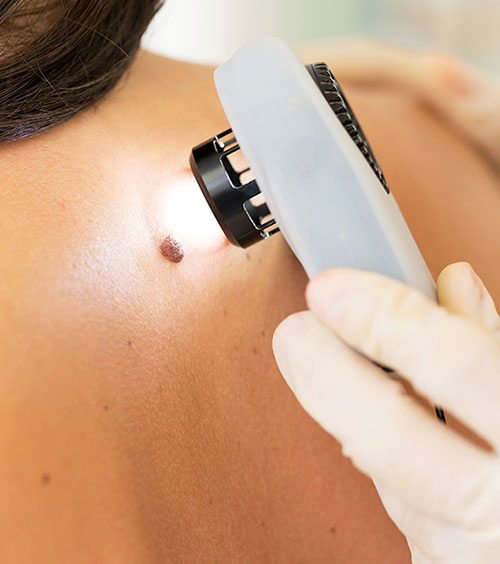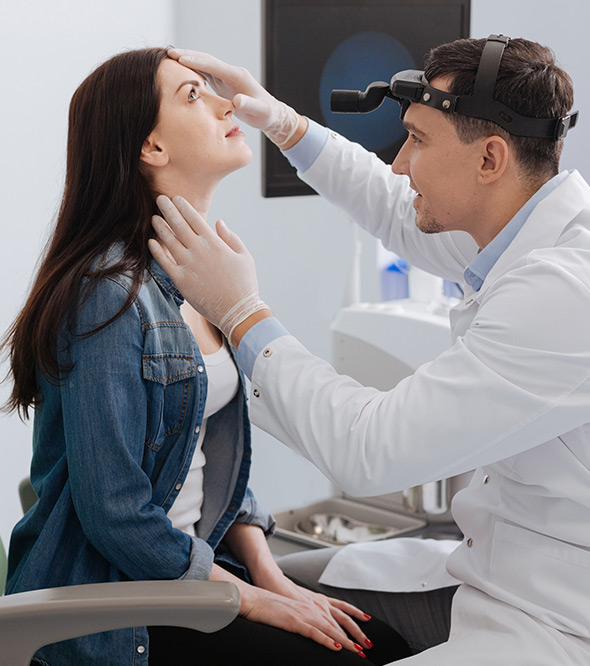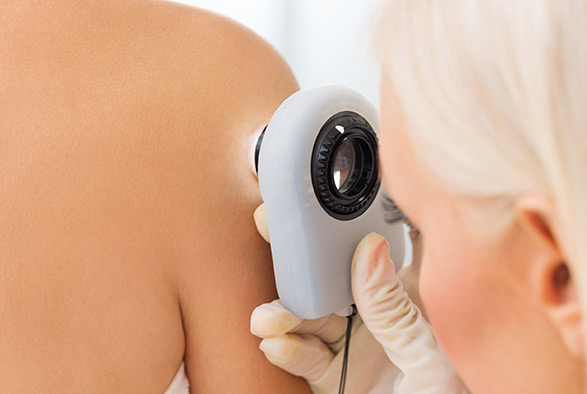Expert Treatment for Squamous Cell Carcinoma
Squamous cell carcinoma is another common type of skin cancer. It is not usually a threat to life as secondary spread is uncommon. Squamous cell carcinoma (SCC) typically affects people of fair complexion. Lesions develop in areas that have been exposed to the sun over a long period. It arises in the squamous cells that compose most of the upper layer of the skin. Commonly they grow slowly over months or years. They may be tender. Some SCCs appear as sores, which fail to heal. A common site is the bottom lip – if a sore has not gone in 3 weeks, get it checked. SCCs are often crusty and may bleed easily. Pre-cancerous lesions known as actinic keratoses can precede SCC. These are red scaly patches or plaques found on the scalp, forehead, face, arms & legs. The lifetime risk of SCC is estimated to be 9% to 14 % among men and 4% to 9% among women.


What Causes Squamous Cell Carcinoma?
Most cases of squamous cell carcinoma are caused by chronic overexposure to the sun. Tumors appear most frequently on the sun-exposed face, neck, bald scalp, hands, shoulders, arms and back. The rim of the ear and the lower lip are especially vulnerable to these cancers.
SCCs may also occur where skin has suffered certain kinds of injury: burns, scars, long-standing sores, sites previously exposed to X-rays or certain chemicals (such as arsenic and petroleum by-products). In addition, chronic skin inflammation or medical conditions that suppress the immune system over an extended period of time may encourage development of the disease.
Occasionally, squamous cell carcinoma arises spontaneously on what appears to be normal, healthy, undamaged skin. Some researchers believe that a tendency to develop this cancer may be inherited.
Who is At Risk?
Anyone with a substantial history of sun exposure can develop squamous cell carcinoma but certain environmental and genetic factors can increase the potential for this disease.
Sun Exposure
Sunlight is responsible for over 90 percent of all skin cancers. Working primarily outdoors, living in an area that gets a lot of high intensity sunlight (like Australia), and spending time in tanning booths all increase your exposure to UV rays and thus increase your risk for developing skin cancer, including squamous cell carcinoma.
Skin Type
People who have fair skin, light hair, and blue, green, or gray eyes are at highest risk. Hispanics, Asians and dark-skinned individuals of African descent are far less likely than Caucasians to develop skin cancer. Check out your skin type and how it affects your skin cancer risk. More than two thirds of the skin cancers that dark-skinned individuals develop are SCCs, usually arising on the sites of preexisting inflammatory skin conditions or burn injuries. It is still essential for them to practice sun protection.
Previous Skin Cancer
Anyone who has had a skin cancer of any type is at increased risk of developing another one.
Reduced Immunity
People with weakened immune systems due to excessive unprotected sun exposure, chemotherapy, or illnesses such as HIV/AIDS are more likely to develop squamous cell carcinoma.


What to Look For?
Squamous cell tumors are thick, rough, horny and shallow when they develop. Occasionally, they will ulcerate, which means that the epidermis above the cancer is not intact. There will be a raised border and a crusted surface over a raised, pebbly, granular base. See photos below for examples.
Any bump or open sore in areas of chronic inflammatory skin lesions indicates the possibility of squamous cell carcinoma, and a doctor should be consulted immediately if this is the case. Usually, the skin in these areas reveals telltale signs of sun damage, such as wrinkling, changes in pigmentation and loss of elasticity. That is why tumors appear most frequently on sun-exposed parts of the body.
The vast majority of SCCs are not serious if detected early and treated quickly. However, squamous cell carcinoma can grow quickly and can be resistant to treatment or locally aggressive, damaging healthy skin around it, sometimes even reaching into bone and cartilage. With delays in treatment, it may be difficult to eliminate, and could result in disfigurement.
Squamous cell carcinomas that are at high risk for metastasis are usually found on the lip, ear, nose, or in persons who are immunocompromised.


There is no one best method to treat all skin cancers and precancers. The choice is determined by many factors, including the location, type, size, whether it is a primary tumor or recurrent carcinoma, the health and preference of the patient, and the preference of the physician. For example, a treatment that has a high cure rate and is painless but leaves a large scar might not be preferred for a tumor on the face.
Almost all treatments can be performed in the physician’s office or in special surgical facilities. Most skin cancer removal can be done using a local anesthetic. Rarely, extensive tumors may require general anesthesia and hospital admission.
Current Methods of Treating SCCs Are:
- Curettage-electrodessication
- Cryosurgery
- Chemotherapy: topical or injection
- Excisional surgery
- Mohs micrographic surgery
- Radiation
- Laser therapy
- Photodynamic therapy

